Maria Isabelle “Beng” Climaco-Salazar: The Defender in Chief
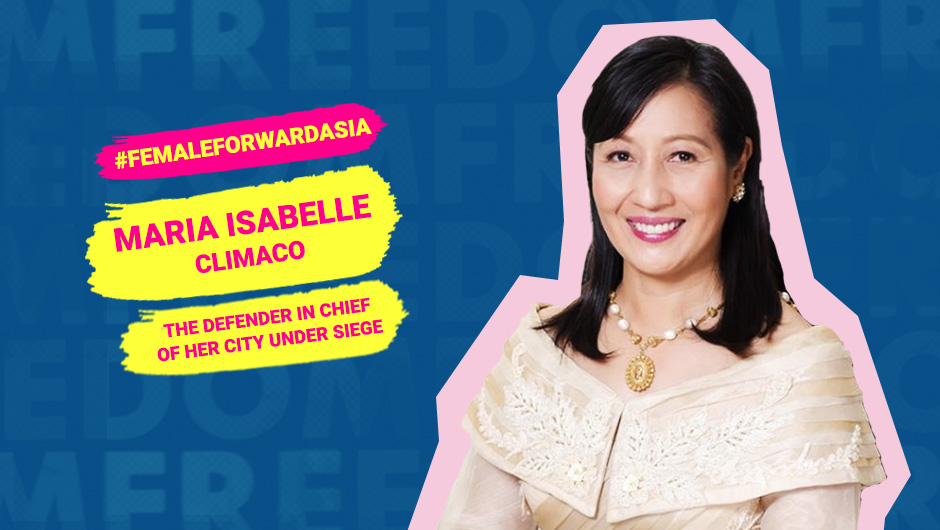
“It was dawn of September 9, 2013 and I was at home. We just arrived the evening before, after launching the City’s newest tourism campaign, Zoom in Zamboanga, in a Travel Expo in Manila. I was informed through SMS by a reporter and got a call from our Chief of Staff and Police Chief. I immediately conferred with the City administrator and decided the cancellation of classes to protect the students, parents and teachers.”
Thus, narrated the mayor of Zamboanga City, the center of commerce, industry and education of the Zamboanga Peninsula (Region IX) in Western Mindanao, and the sixth most populous city and third largest in land area in the country. Only after a few hours arriving from the Philippine capital after promoting to the nation and the rest of the world her beloved Zamboanga of which there are many reasons to visit, she returned home to a city in the brink of war. Her tourism campaign aimed to put Zamboanga City in the limelight. She had no idea that it would be in the headlines as the major national news story in the days and weeks to come. But all for the wrong reasons.
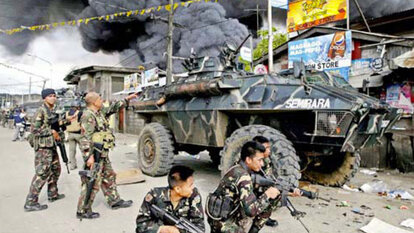
Maria Isabelle Climaco-Salazar, or known as simply Beng Climaco, quietly celebrated her birthday two days before that eventful day. She had been mayor for only two months and nine days but she carried with her decades of experience both within and outside pol- itics and governance—all of which proved useful as the neophyte mayor albeit seasoned leader was faced with the toughest challenge of her career; it was more so, the biggest threat to the city’s security and wellbeing in recent memory.
Before being elected mayor in the May 2013 elections where she received the highest mandate in the city’s history, she was a two-term city councilor from 1998 to 2004 after which she was immediately elected as Vice Mayor. From being a local legislator and head of the city council, she became the city’s representative in Congress for two consecutive terms (2007 to 2013). During her second term in the House of Representatives, she became one of the six deputy speakers, overcoming the barriers of age and gender—she was both the youngest and the only woman who held that post during the 15th Congress.
She finished her secondary education in the United States and became a novice in a Catholic convent. She was an educator and guidance counsellor with a Master’s degree in Family Ministry and Counseling from Ateneo de Manila University, the country’s leading Jesuit learning institution. She holds the rank of Lieutenant Colonel as a reservist in the army. She is married to General Trifonio Salazar.
The Moro National Liberation Front (MNLF), a Muslim separatist group, started its insurgency campaign way back in 1973 after President Marcos declared Martial Law (Encyclopaedia Brittanica, n.d.). On 9 September 2013 at dawn, more than 500 rebels from an MNLF faction led by Nur Misuari stormed into Zamboanga City onboard boats (Saavedra, 2018). They took over several coastal villages, triggering a standoff between government forces and the rebels who held civilians hostage (Philippine Daily Inquirer, 2014). The assault, apparently aimed at thwarting a government peace plan with its rival Moro Islamic Liberation Front (MILF), paralyzed the city of over a million residents, razed 10,000 homes and reduced once-thriving communities to rubble (Philippine Daily Inquirer, 2014).
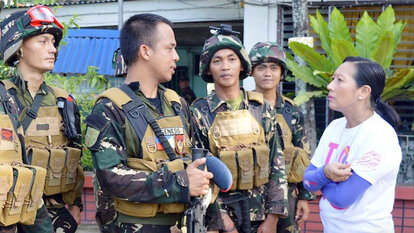
“The MNLF wanted the full implementation of the 1996 Peace Agreement. The discontentment stemmed from MNLF’s perception of being left out in the peace process with the MILF,” Climaco responded when the author asked her what motivated the MNLF to attack the city. “There was a wrong appreciation of Misuari’s capability to cause chaos despite intelligence reports, because some branded Misuari as a ‘spent force’. As a result, we ended up spending so much, including lives of innocent civilians and security forces who fought in defense of Zamboanga City and our Republic.”
“I first led the Crisis Management Committee, but the crisis was eventually elevated to the national level with the presence of cabinet members and the Commander in Chief,” she narrated. Then President Benigno “Noynoy” Aquino, III spent several days in Zamboanga, and so did the Secretaries of National Defense, and Interior Local Government, among others. “I was still part of the security cluster and remained the voice of government and of the people during those trying times. Likewise, I focused on humanitarian response, alongside with the Social Welfare Secretary, in addressing the needs of over 120,000 displaced individuals.”
Branded by the United Nations as a humanitarian crisis, the Zamboanga Siege, which lasted for 20 days, resulted in the death of 132 people, the displacement of more than 100,000 city residents and more than 8,000 in nearby Basilan province, and the destruction of more than 10,000 homes (United Nations, 2013).
“I feared the death of the hostages. Thank God they were released but still precious lives were lost in the crossfire, such as the young student who was set to graduate,” the mayor and former educator who once taught English and Religion and served as guidance counsellor at Ateneo de Zamboanga lamented when I asked her what her biggest fears were during the crisis. “Another was a three-year-old boy, Ethan Ando, who was hit by a bullet in his forehead. He was the youngest hostage to die from the siege while both his parents (were) held as captives. This gave me the firm resolve to stand-up in their defense and seek justice as no innocent civilian must suffer because of cruel and selfish intentions of others.”

The author asked her, with the benefit of hindsight, what could have been done better during the siege by the military and the civilian government, both local and national. “The security forces initiated a pre-emptive, calibrated response with the objective of neutralizing the enemy while being able to rescue the hostages. It would be clear if the Crisis Management Manual be accessible and comprehensible to local governments and even to many in the national departments. A team ready to negotiate with the hostage takers, which have a significant knowledge of peace process and a full understanding of its socio-political implications would have been helpful. In fact, it could have been prevented had negotiations and agreements been surely inclusive. Most importantly, the Office of Presidential Adviser on the Peace Process (OPAPP), being the arm which advises national government on such concerns, should have never underestimated the potency of the MNLF while engaging with the MILF. It should have heeded intelligence and security reports related to the group’s plan to stir chaos. The failure to act on intelligence reports had been catastrophic.”
There’s a light side to the crisis between the two key players as reported by the Philippine Daily Inquirer. During the mayor’s brief talk with MNLF leader Nur Misuari at the height of the siege, he raised his voice and as Climaco recalled, “He softened a little after I told him that I was a guidance counselor of his children” (Dizon, 2013).
Maguindanao Representative, Bai Sandra Sema, said Climaco’s leadership style has a “woman’s touch. She’s very sweet but she’s strong, diligent and systematic. It’s like how you would plan for your household. She identifies right away what is needed the most” (Dizon, 2013).
“In 2004, I was single and was running for Vice-Mayor. My opponent harassed me saying that, ‘I am already dried-up,’ to directly attack my womanhood and my capacity to give birth. It was cruel and prejudicial. He lost the election for Vice Mayor” (National Democratic Institute, n.d.).
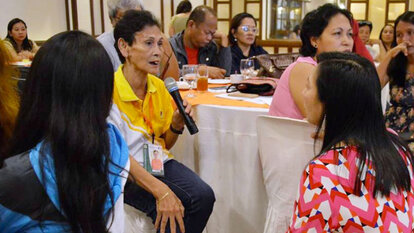
“Being female is quite challenging in the field of politics. Cultural and religious mindsets would prefer a male who is viewed to be endowed with strength and power genetically. Society is biased against women leaders who view us, as weak and emotional,” Climaco stated candidly when the author asked about gender barriers she encountered in politics.
“But this in itself is what is enigmatically fascinating about this ste- reotypical myth. Once women excel in the field of public service, we break the barriers that imprison society’s norms and limitless possibilities happen. I always say never ever underestimate the strength of a woman. This was proven in the MNLF attack of the City. I penetrated the battle line and went as far as the only elected official to file a case against the MNLF, because I will fight for justice especially for the helpless innocent victims of the siege.”
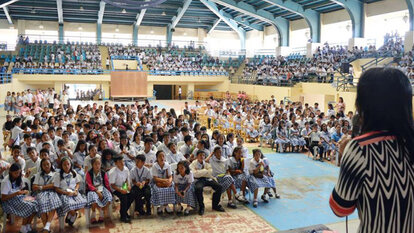
An advocate for women and children’s rights, Climaco was inspired by her grand- mother, who was a principal author of the Magna Carta of Women (Republic Act 9710) (National Democratic Institute, n.d.). “My grandmother, Isabel, who was a suffragist and a strong advocate of Filipino women’s rights, was also a teacher.”
A major influence in her life is her uncle, Cesar Climaco, who was mayor of Zamboanga for eleven years beginning in the 1950s. He attained national prominence during Martial Law as one of the fiercest and most fearless critics of the Ferdinand and Imelda Marcos.
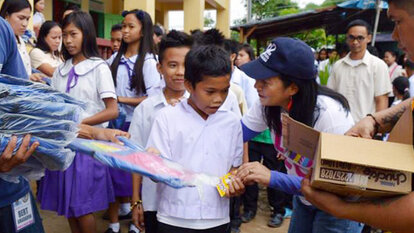
“I was ‘an accident!’ who was conceived while my father was helping out his brother, Cesar Climaco, in his electoral protest on December 1965,” Climaco narrated. “Uncle Cesar won a seat in the Senate, but eventually lost his seat after the Supreme Court declared a statistical improbability for a candidate of a major political party to get zero in Lanao. On my 18th birthday, Uncle Cesar said that he thought I would never survive, because I was a frail baby. It is only now that I realize, I was conceived from his loss. I used to march with him in protest for the death of Ninoy Aquino. He taught me to fight for justice and to uphold the rule of law.”
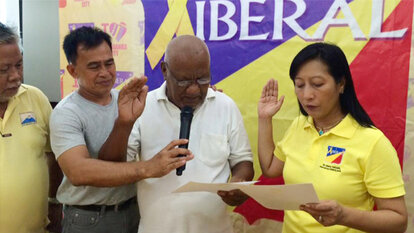
Mayor Cesar Climaco was assassinated in 1984, one of the many martyrs of the Liberal Party during the dark days of the conjugal dictatorship.
“In 1995, my dad lost the elections for Mayor and being his youngest and only daughter, I felt his pain. It was because of this that in 1998, when I also lost a part time job, I said yes to help Zamboanga City. This invitation came from my godmother,
Mayor Caling Lobregat,” the second female mayor of Zamboanga narrated; interestingly, Lobregat was the first. “The Climaco brand of community service is a trait taught by my Abuelita Isabel, to her children and passed on to us. My dad, Jolly, who was a former Vice Mayor tutored me on the work of legislation. He taught me to be honest and to be a fiscalizer. He is an inspiration in public service. I thank God I was able to make him happy before he died, by being elected as a Councilor. He gifted me with a book, Republic Act 7160, the Local Government Code, after my oathtaking and told me to study it like a bible.”
The author then inquired what made her finally decide to enter politics and become a Liberal like many in her family. “I was asked if I wanted to help Zamboanga. But deep within I wanted my dad to be happy and experience victory after losing his last political battle. My dad run as a member of the Liberal Party and my Uncle Cesar was a member of the LP with (Ninoy) Aquino and (Gerry) Roxas, during the dictatorship. It was in November 2009 that I took my oath in the Liberal Party since this was the party that the family has been part of.”
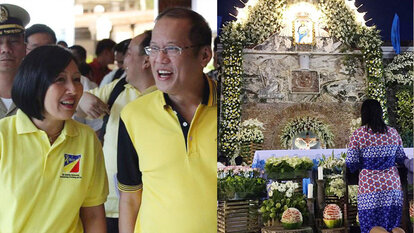
The second is devout Catholicism.
Both Zamboanga City and Region IX are predominantly Catholic. A Marian devotee, the young Beng was a novice who almost became a nun. “I was a postulant in the Carmelites’ Missionary, a teacher and a guidance counselor in the Jesuit-run, Ateneo de Zamboanga.
Yes, I intended to be a nun right after college. However, after a process of discernment and prayer, I realized I had a calling to go out and face the world. Just like Maria in the Sound of Music! This was also where my formator, Sr. Joy, discovered my gift of public service, since I was exposed in the urban poor communities when a postulant.”
But it must be pointed out that despite the siege, Moslems, Christians and indigenous peoples have been living most often in harmony for more than four centuries in Zamboanga City.
The third legacy is literally more concrete: Fort Pilar. Built in the 17th Century as a military fortress, it is also a Marian Shrine for the Our Lady of Pilar, the patron saint of Zamboanga City. The fort is an enduring symbol of Spanish colonialism and the Catholic faith. Built by the Jesuits in 1635 as a defense against raids by Moslem pirates from Mindanao and Jolo, 378 years later, the fort’s raison d’etre seemed to have found a renewed significance.
Ancient stone walls are of little value in modern warfare. But fortunately for Zamboanga City and its people, they had a formidable Defender in Chief whose competent and inspiring leadership provided the contagion of strength and grace while the entire city population was under duress.
Her multifarious and multifaceted talents in politics, governance, management, psychology, education, military and religion were literally put to test during the crisis. And she proved to be the right mayor at a time when things in the city went wrong.
With the crisis over, the city went to rehabilitation mode. “Security, health and education are now our priorities. We have the Zamboanga City Roadmap to Recovery and Rehabilitation and have set up security infrastructures, including the Naval Station in the area where the siege began. We have invested more than 1.5 billion pesos for security to support the security sector in keeping the City safe. It is our primary policy to make services of government accessible to all – Christians, Moslems and Indigenous Peoples. We envision growth and development to be inclusive.”
As the mayor’s Chief of Staff, Michael Saavedra noted, “Zamboanga City, even after the siege, got an influx of investments. The National Cities Competitiveness Council cited Zamboanga City as one of the two Most Improved City and the fourth Most Resilient in the Philippines in 2016.” This year, Climaco is in the shortlist of 27 women mayors nominated by the City Mayors Foundation for the 2018 World Mayor Prize, the only Filipino and one of only four Asians (World Mayor, 2018).
“Looking back, it was solid faith in God and our Blessed Mother, the Nuestra Señora La Virgen del Pilar, the Patroness of Zamboanga, that kept me on the battle. The siege might have ended, but five years later the memories of those who died are still fresh in the minds of their loved ones,” Climaco reminisced.
“We are still inching our way to rehabilitation—a battle for housing, water, electricity and sanitation continues. The rebuilding of trust amongst Christians, Moslems and the Indigenous communities, the healing of the wounded spirit, goes on. What is consoling is seeing grandmothers, mothers and daughters learning to write their names and be literate, a housewife, busy with colorful clothes in her sewing machine- a grant from our foreign donors and a mother able to joyfully earn a living in her new home. Today, many of these homes are filled with vegetable patches even in houses on stilts. We are indeed on our way to Build Back a Better Zamboanga City!” the mayor declared with optimism and determination.
The Spaniards built the walls of Fort Pilar to protect the city from pirates, marauders, and insurgents. Beng Climaco, instead, chose the opposite approach. She is breaking barriers and building bridges.
References
City Government of Zamboanga. (2005, June 21). Historical Background. Retrieved from City Government of Zamboanga: http://www.zamboanga.gov.ph/index.php?option=com_content&task=view&id=1…
Dizon, N. (2013, September 29). Zamboanga City mayor: From novice to warrior. Retrieved from Inquirer: https://newsinfo.inquirer.net/497225/zamboanga-city-mayor-from-novice-t…
National Democratic Institute. (n.d.). Beng Climaco. Retrieved from National Democratic Institute: https://www.ndi.org/beng-climaco
Philippine Daily Inquirer. (2014, September 08). What Went Before: The MNLF siege of Zamboanga City. Retrieved from Inquirer: https://newsinfo.inquirer.net/635995/what-went-before-the-mnlf-siege-of…
Saavedra, M. (2018, November 07). E-mail Correspondence.
The Editors of Encyclopaedia Brittanica. (n.d.). Moro National Liberation Front. Retrieved from Encyclopaedia Brittanica: https://www.britannica.com/topic/Moro-National-Liberation-Front
United Nations. (2013, October 08). UN emergency funding approves $3 million for crisis in southern Philippine. Retrieved from UN News: https://news.un.org/en/story/2013/10/452622-un-emergency-funding-approv…
World Mayor. (2018). World Mayor: Zamboanga City Mayor Beng Climaco. Retrieved from World Mayor: The year’s most outstanding mayors: http://worldmayor.com/contest_2018/comments-zamboanga-mayor-climaco.html
_______________________
First published on the book, Compelled by Duty, Conscripted by Destiny: Portraits of 16 Asian Women at the Frontline of Democratic Struggle, authored by John Joseph S. Coronel.
In cooperation with the Council of Asian Liberals and Democrats (www.cald.org)